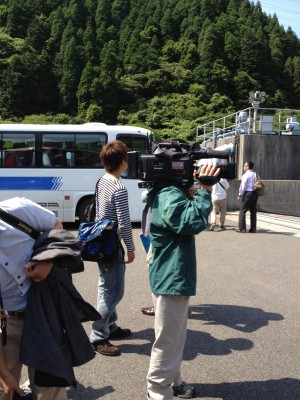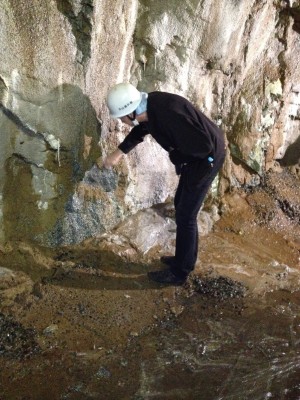On 22 May, a small room at Kyushu University’s Hakozaki campus was crowded with journalists and local officials of the Kyushu area. A press briefing was held one day before the starting day of lively discussions on one of the detector concepts for the International Linear Collider, the ILD workshop.
“I appreciate the media’s interests in the ILC activities in Kyushu area,” said Kiyotomo Kawagoe, professor at Kyushu University, who acts as a chair of the organising committee of the ILD workshop, and also a speaker of the press briefing. Despite the very short notice, many reporters and TV crews gathered to listen to the lectures about the ILC.
Kawagoe started the press briefing by introducing the ILC, giving the basic information such as size and energy, and the importance of the research to be done at the ILC.
Tetsuro Esaki, professor by special appointment at Kyusyu University in geological investigation, followed Kawagoe. Esaki, who has broad experience and expertise in geological research, will oversee the detailed site study in Kyushu area, after the contract research agreement between Kyushu University and KEK has become effective. This contract is expected to be signed in a few weeks.
“The geology in the Kyushu area has been surveyed many times at many places for various purposes, such as train tunnel constructions, hot-spring trial borings, or underground power plant construction,” Esaki said. Scientists and local affiliates have made investigations with the help of a lot of accumulated data and additional field investigations around the Kyushu site. “We conclude that the geological characteristics around the planned ILC site are pretty suitable for the ILC,” said Esaki.
KEK received an additional appropriation from the government early this year to conduct geological investigations for two ILC candidate sites in Japan. Kyushu University will be responsible for the site investigations on the so-called “south site.” There are two candidate sites for ILC construction in Japan, one in Iwate prefecture, in the northeast area of Honshu island (“the north site”), and the south one that sits across the border between Fukuoka and Saga prefectures in Kyushu island.
“I have done many geological investigations, but this will be the toughest case,” Esaki said. They will need to investigate over 500 square kilometres in Fukuoka and Saga. “It is pretty unusual to investigate such a huge area in short time with rather smaller budget.” They will compile the date from this investigation and put the report together by the end of March 2013. “We consider this investigation as a primary one, and hope to have secondary and tertiary investigation to follow,” Esaki said.
Following the press briefing, journalists and researchers were given a tour around the planned ILC site. Over 70 people including 56 researchers form Japan and overseas were divided into two buses. Their first stop was the Tenzan underground power plant, a pumped-storage power generation built 500 metres underground. Visitors went down to the underground cavern through the tunnel. If the ILC will be built in a mountain area, scientists might reach the ILC accelerator tunnel in a similar fashion. Tour attendees actually hit the bedrock with hammer and checked the hardness of the rock.
With many newspaper articles about ILC published in the morning (see last week’s issue of NewsLine) the ILD workshop started on the next day, and successfully finished on 25 May.
Originally, the ILD workshop had been supposed to take place at KEK last year, but the venue for that meeting was changed to Paris due to the major earthquake. “This workshop was an impressive one for me, because it was the first ILD workshop held in Japan after the earthquake,” said Kawagoe. “The broad media coverage was also impressive. I will show the recorded TV news in the workshop!”
Scientist saw lots of progress on ILD in the workshop. They actually see that the content of Detailed Baseline Design report, which they are planning to publish early next year, is becoming clearer and clearer. Many open issues from Paris meeting were resolved, or became close to resolution. But they are also behind schedule in some areas. Ties Behnke from DESY, Germany, stated in his closing talk that “if we make a coherent effort we can finish a very good DBD in time!”



Recent Comments